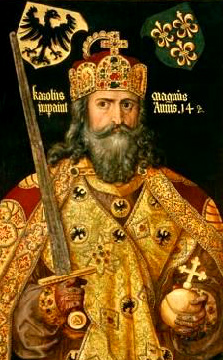Charlemagne Biography
750 - 985
"One God, one empire and one religion"
|
Charlemagne was crowned Holy Roman Emperor by Pope Leo III at the Church of St. Peter in 800. Charlemagne desired to re-establish the art and cultural accomplishments of classical Rome. He supported numerous artistic and cultural endeavors, including monastic centers that were established to create and produce illuminated manuscripts. During the Carolingian Period monasteries became the principal artistic centers. These early artists were Franks who had modeled their style after the works of Greek, Roman and Middle Eastern artists. According to noted historican, Paul Lacroix "Under the government of Charlemagne, the private life of his subjects seems to have been less rough and coarse, although they did not entirely give up their turbulent pleasures. Science and letters, for a long time buried in monasteries, reappeared like beautiful exiles at the imperial court, and social life thereby gained a little charm and softness. Charlemagne had created in his palace, under the direction of Alcuin, a sort of academy called the "School of the Palace," which followed him everywhere. The intellectual exercises of this school generally brought together all the members of the imperial family, as well as all the persons of the household. Charlemagne, in fact, was himself one of the most attentive followers of the lessons given by Alcuin. He was indeed the principal interlocutor and discourser at the discussions, which were on all subjects, religions, literary, and philosophical." Art during the time of Charlemagne Art historian Clara Erskine Clement states "When Charlemagne became the king of the Franks in 768, there was little knowledge of any art among his northern subjects; in 800 he made himself emperor of the Romans, also, and when the Franks saw all the splendor of Rome and other parts of Italy, it was not difficult for the great emperor to introduce the arts into the Frankish portion of his empire. All sorts of beautiful objects were carried from Italy by the Franks, and great workshops were established at Aix-la-Chapelle, the capital, and were placed under the care of Eginhard, who was skilled in bronze-casting, modelling, and other arts; he was called Bezaleel, after the builder of the Tabernacle. We have many accounts of the wall-paintings and mosaics of the Franks; but there are no remains of them that can be identified with positive accuracy.Miniature-painting flourished under the rule of Charlemagne and his family, and reached a point of great magnificence in effect, though it was never as artistic as the work of the Italian miniators; and, indeed, gradually everything connected with art was declining in all parts of the world; and as we study its history, we can understand why the terms Dark Ages and Middle Ages are used to denote the same epoch, remarkable as it is for the decay and extinction of so many beautiful things." |
|
|
|
|
| Key terms associated with the Middle ages - Gothic, black death, the shivering style, crusades, hagiographical literature, leprosy, biblical symbolism, mysticism, feudal system, serfs, peasants, Byzantine style, illuminated manuscript, scriptorium, illuminator, plague | |
|
Major Painters of the Middle-Ages
Cimabue Require more facts and information about the Middle- Ages? Poke around every nook and cranny of the known universe for information this subject. Search Here © HistoryofPainters.com If you like this page and wish to share it, you are welcome to link to it, with our thanks. If you feel you have worthwhile information you would like to contribute we would love to hear from you. We collect essential biographical information and artist quotes from folks all over the globe and appreciate your participation. When submitting please, if possible, site the source and provide English translation. Email to millardmulch@gmail.com |
| “To be an artist is to believe in life.” Henry Moore The Meaning of Sacred Symbols in Paintings. Most prominently featured symbols and their meaning: |
